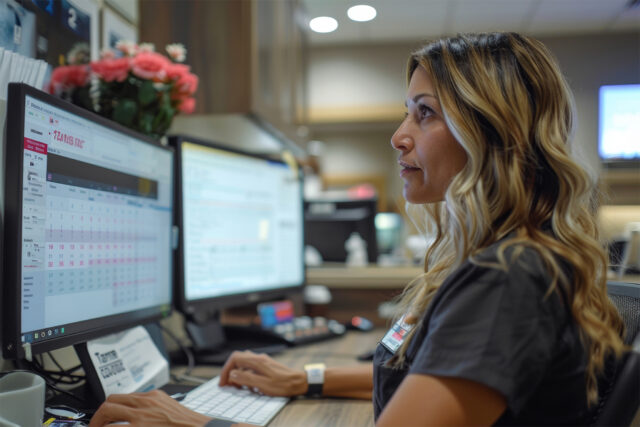1st Runner-Up Scholarship Winner, Rebecca Kraven
The patient-provider relationship has been fraught with difficulties and subtleties since Hippocrates started documenting the clubbing of the fingers. Some of these problems stem from the patient preferring not to be fully honest when describing symptoms, leading the provider with only a partial picture to generate a diagnosis. At times, healthcare professionals will struggle to communicate the necessity of preventative treatment regimens and cannot know which elements of treatment will appeal or deter a patient from compliance. Due to these and countless other communication and compliance struggles, the healthcare industry faces problems like ineffective treatment plans, long-term unresolved health conditions, and general patient dissatisfaction.
Although doctor-patient communication is problematic in many ways, it is important for the patient’s wellbeing to be able to communicate without fear of judgment and to be open about all health-related concerns. Patient engagement technology has provided a solution to many of the communication problems experienced by healthcare organizations. It can drastically improve long-term health outcomes by empowering the patient to take control of their health, making it more convenient for them to maintain their health plan, and offering supportive communities.
Patient engagement technology plays a major role in empowering individuals to take control of their health and monitor their treatment plans by giving them power over their schedule and by placing the necessary tools at their fingertips. By transferring some of what has traditionally been considered the doctor’s control and responsibility to the patient, the patient will, in turn, feel empowered to own the responsibility for maintaining a healthy lifestyle and following a health plan.
By creating an account through their health network, patients can view their records, read doctor reviews before scheduling consultations with sites like Yelp and Healthgrades, access their lab results, and find health information from alternative sources. These interactive tools encourage individuals to put more energy into their well-being, which could lead to more targeted treatment plans.
With the expansion of patient engagement solutions to mobile devices and wearable technology, the patient has even greater control over their health and wellness by utilizing tools that monitor their progress without having to schedule an appointment with the doctor. Mobile apps like Apple’s HealthKit send results and metrics to the clinician directly, and iGetBetter is a way for post-surgical patients to take control of their recovery and is working to decrease the rate of post-discharge re-admissions. Even new mothers are jumping on patient engagement technology like FirstOpinion as a way to receive health tips specifically from doctors who are mothers themselves without the hassle of the appointment or the waiting period that often accompanies it.
Yet another way engagement technology has improved patient care is through the development of online platforms where mental health experts can provide help on short notice while protecting the patient’s anonymity. All of these aspects work to give more power back to patients to control their long-term health.
With the development of patient engagement technology, convenience will soon be the most critical factor in influencing patient behavior. In other words, the ability to maintain their health and follow doctor-recommended health plans in a way that is practical for their lifestyle. It can take anywhere from 2 to 4 weeks of waiting before a patient can get into a doctor’s office for an appointment. On top of that, consider the amount of time the patient must invest to follow what might be a strict, complicated health plan–they will most likely not be able to maintain compliance. Individuals lead busy lives, and even when it comes to their personal health and wellness, it is challenging to balance life’s demands.
However, technology that patients can access and customize to automate reminders and send information will make it easier for them to maintain control over their health without sacrificing their daily routines. Websites like Joyable are facilitating anxiety sufferers’ receiving Cognitive Behavioral Therapy by initiating a phone call and then following up via text, email, or phone, thereby decreasing the stigma associated with many mental disorders. Or even if it comes down to consumers using a toothbrush that will automatically remind them when it’s time for a new brush.
By utilizing patient engagement technology, the doctor can see if the patient is following the health plan without the patient having to schedule and wait for an appointment. The doctor will then be able to make more educated suggestions and diagnoses, equipped with the knowledge and feedback from the patient via the technology itself. This is especially the case when considering the use of noninvasive, wearable technology in the healthcare industry.
In addition to the direct physical benefits of patient engagement technology for the consumer, there are also the benefits of connecting with a community of supporters who may be struggling with the same health conditions, decisions, and emotions. Or even caregivers who can provide comfort and aid to those suffering from chronic long-term conditions. The added benefits of such a community to the health outcomes of the patient are two-fold; not only does it provide a venue that allows connections with people who can share the successes and failures of a treatment plan, but it also gives the patient the emotional support of people who are experiencing or have experienced the same struggles. This support can be critical to long-term health outcomes because it prevents the patient from feeling isolated or discouraged by the illness and may be the catalyst to continue what might otherwise seem like an impossibly complex or strict treatment plan.
Although it is easy to become cynical about new technology entering a field that previously did not have access to such incredible innovation, it is important that patients and healthcare providers alike adopt patient engagement technology to increase treatment effectiveness and optimize the overall patient experience. This type of development may be the turning point for someone struggling with one or several chronic conditions.
Patient engagement technology allows patients the ability to take control of their health regimens and decisions without sacrificing their goals and dreams. The incredible technology available today offers so much for the patient to use to their ultimate benefit and can vastly improve quality of life and long-term health outcomes. Technology like this could be the difference between a robust and active life versus one confined by illness and homebound limitations.



